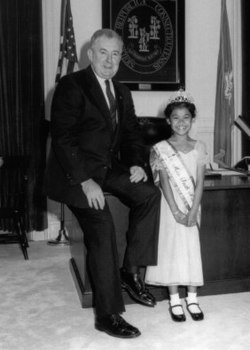It has been requested that the title of this article be changed to List of governors of Connecticut . Please see the relevant discussion on the discussion page. The page should not be moved unless the discussion is closed; summarizing the consensus achieved in support of the move. |
| Governor of Connecticut | |
|---|---|
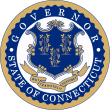 Seal of the Governor | |
| Style | His Excellency |
| Residence | Connecticut Governor's Residence |
| Term length | Four years |
| Inaugural holder | Jonathan Trumbull |
| Deputy | Lieutenant Governor of Connecticut |
| Salary | $150,000 (2013) [1] |
| Website | www.ct.gov/governor |
The Governor of Connecticut is the elected head of the executive branch of Connecticut's state government, and the commander-in-chief of the state's military forces. The governor has a duty to enforce state laws, and the power to either approve or veto bills passed by the Connecticut General Assembly and to convene the legislature. [2] Unusual among U.S. governors, the Governor of Connecticut has no power to pardon. [3] The Governor of Connecticut is automatically a member of the state's Bonding Commission. He is an ex-officio member of the Board of Trustees of the University of Connecticut and Yale University.

In the United States, a state is a constituent political entity, of which there are currently 50. Bound together in a political union, each state holds governmental jurisdiction over a separate and defined geographic territory and shares its sovereignty with the federal government. Due to this shared sovereignty, Americans are citizens both of the federal republic and of the state in which they reside. State citizenship and residency are flexible, and no government approval is required to move between states, except for persons restricted by certain types of court orders. Four states use the term commonwealth rather than state in their full official names.

In the United States, a governor serves as the chief executive officer and commander-in-chief in each of the fifty states and in the five permanently inhabited territories, functioning as both head of state and head of government therein. As such, governors are responsible for implementing state laws and overseeing the operation of the state executive branch. As state leaders, governors advance and pursue new and revised policies and programs using a variety of tools, among them executive orders, executive budgets, and legislative proposals and vetoes. Governors carry out their management and leadership responsibilities and objectives with the support and assistance of department and agency heads, many of whom they are empowered to appoint. A majority of governors have the authority to appoint state court judges as well, in most cases from a list of names submitted by a nominations committee.

The Connecticut General Assembly (CGA) is the state legislature of the U.S. state of Connecticut. It is a bicameral body composed of the 151-member House of Representatives and the 36-member Senate. It meets in the state capital, Hartford. There are no term limits for either chamber.
Contents
There have been 68 post-Revolution governors of the state, serving 72 distinct spans in office. The longest terms in office were in the state's early years, when four governors were elected to nine or more one-year terms. The longest was that of the first governor, Jonathan Trumbull, who served over 14 years, but 7 of those as colonial governor; the longest-serving state governor — with no other position included in the term — was his son, Jonathan Trumbull Jr., who served over 11 years. The shortest term was that of Hiram Bingham III, who served only one day before resigning to take an elected seat in the U.S. Senate. Lowell P. Weicker Jr., is noted for a rare third party win in American politics, having been elected to a term in 1990 representing A Connecticut Party.
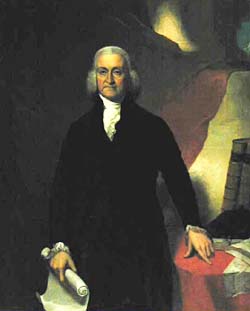
Jonathan Trumbull Sr. was the only man who served as governor in both an English colony and an American state, and he was the only governor at the start of the American Revolutionary War to take up the Patriot cause. Trumbull College at Yale, the town of Trumbull, Connecticut, and Trumbull County, Ohio are named after him.
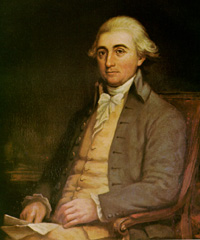
Jonathan Trumbull Jr. was an American politician who served as the 20th governor of Connecticut and the second Speaker of the United States House of Representatives.
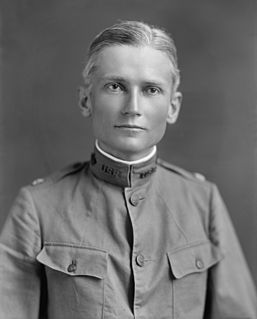
Hiram Bingham III was an American academic, explorer and politician. He made public the existence of the Inca citadel of Machu Picchu in 1911 with the guidance of local indigenous farmers. Later, Bingham served as a member of the United States Senate for the state of Connecticut.
The current governor is Ned Lamont, a Democrat who took office on January 9, 2019.

Edward Miner Lamont Jr. is an American businessman and politician serving as the 89th Governor of Connecticut since January 9, 2019. A member of the Democratic Party, he won the 2018 gubernatorial election, defeating Republican Bob Stefanowski and independent Oz Griebel.

The Democratic Party is one of the two major contemporary political parties in the United States, along with the Republican Party. Tracing its heritage back to Thomas Jefferson and James Madison's Democratic-Republican Party, the modern-day Democratic Party was founded around 1828 by supporters of Andrew Jackson, making it the world's oldest active political party.






























































